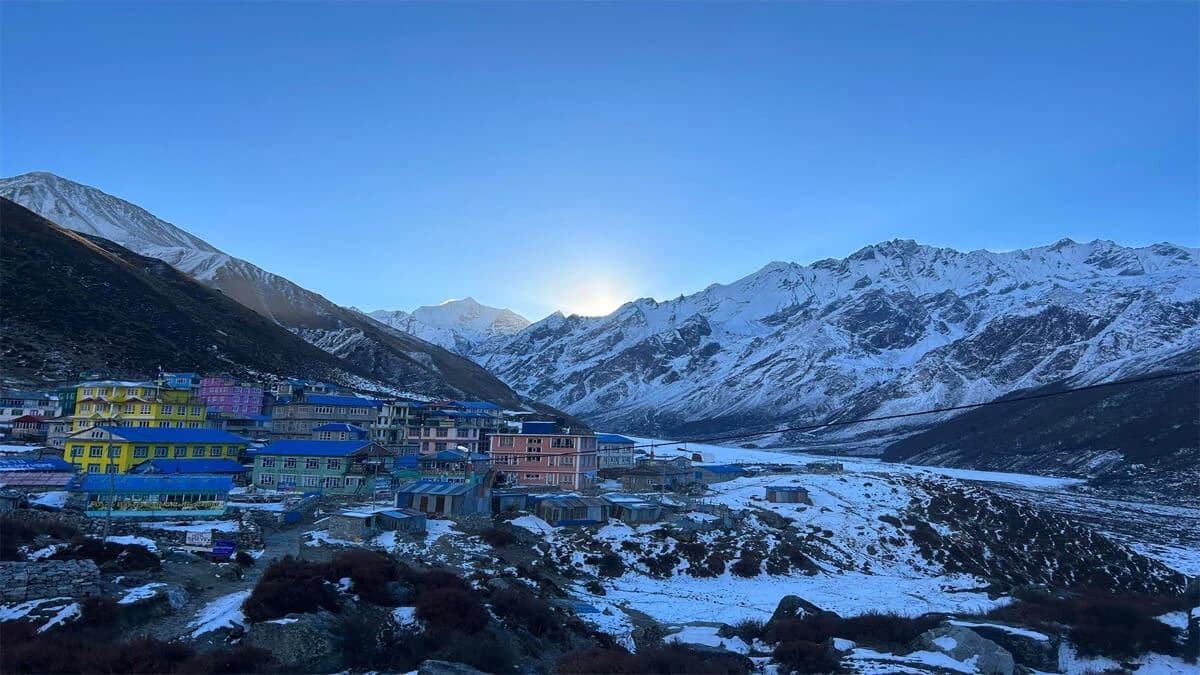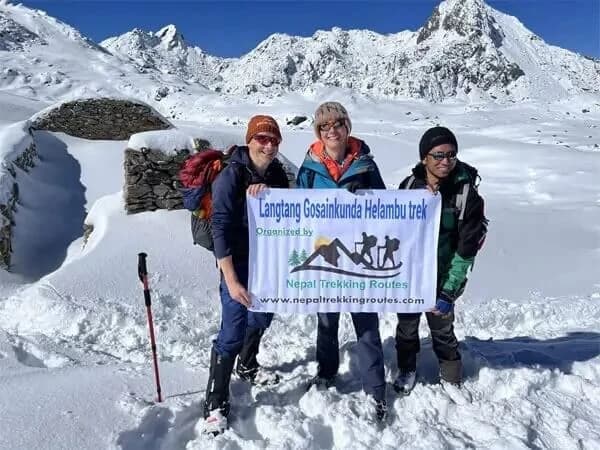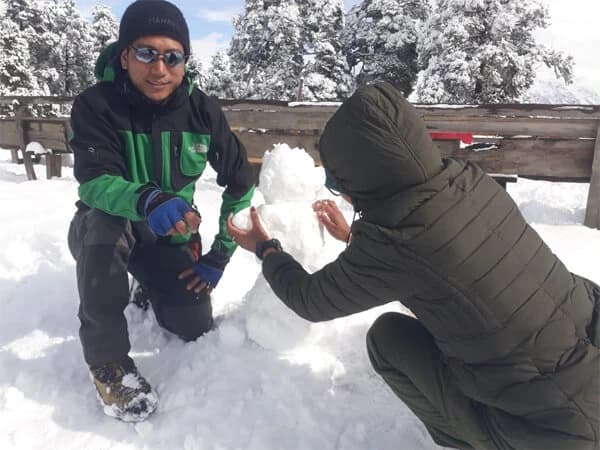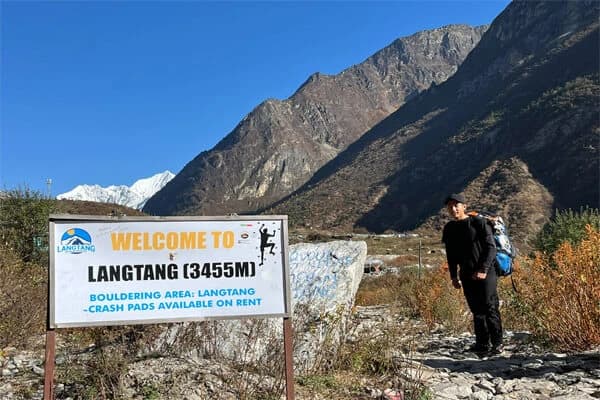The Langtang Valley Trek is a moderate trekking option in Nepal, covering roughly 60 to 70 kilometers round trip. Starting at Syabrubesi, the route travels via charming settlements including Lama Hotel, Langtang Village, and Kyanjin Gompa. Side climbs to Kyanjin Ri (4,773m) and Tsergo Ri (4,984m) are optional. Depending on pace and terrain, daily walking distances can range from 8 to 12 kilometers, with a gradual elevation climb to help acclimate. For beginners and experienced trekkers looking for a manageable yet satisfying excursion in the Langtang Valley, the trek offers a gratifying Himalayan adventure by combining a moderate distance, beautiful scenery, and cultural experiences.
Langtang Valley Trekking Daily Walking Distance
Ever wonder how far you could walk on one of the most picturesque Himalayan treks in Nepal? One of the most fulfilling short hikes close to Kathmandu is the Langtang Valley Trek, which offers breathtaking mountain views, serene paths, and a wealth of cultural experiences. The route progressively ascends toward the magnificent Kyanjin Gompa, encircled by snow-capped peaks, passing through rhododendron forests, high alpine meadows, and little Tamang villages.
Before embarking, it is crucial to know theLangtang Valley trekking distance because it aids in pace planning, physical preparation, and expectation management for each day's walk. Langtang offers a rewarding trip with a moderate level of difficulty, but not being as long or as high as the Everest or Annapurna climbs.
From total kilometers and walking hours to altitude gain and terrain characteristics, this blog covers all the information you need to know about the Langtang Valley Trekking Distance. For hikers who wish to see the Himalayas without committing to a lengthy journey, it is a useful resource. Knowing the distance will enable you to appreciate the beauty and rhythm of the Langtang trail which winds step by step through one of Nepal's most tranquil mountain valleys to the fullest, regardless of your level of hiking experience.
Langtang Valley Trek Route Map
Langtang Trek Route Overview
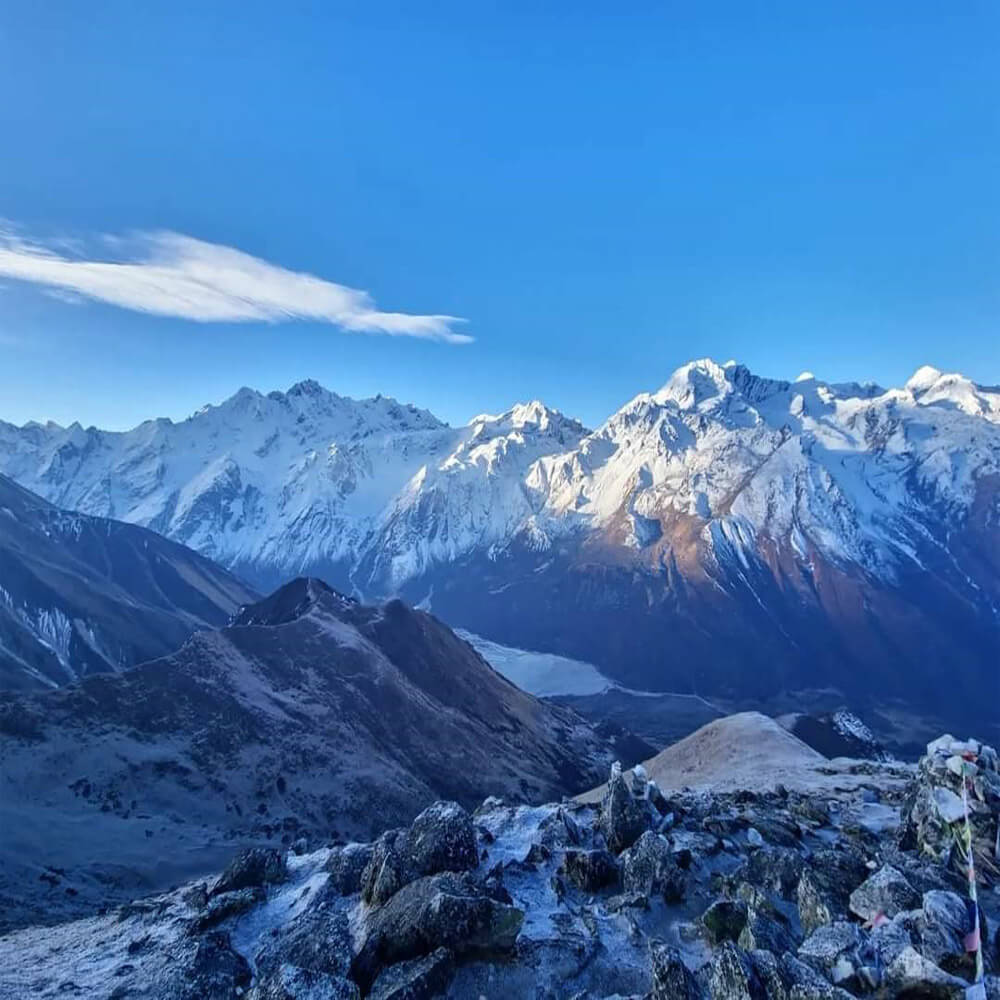
Situated just north of Kathmandu, the Langtang Valley Trek is one of Nepal's most accessible and picturesque hikes. The journey, which begins in Syabrubesi (1,503m), offers a blend of natural beauty and cultural encounters as it progressively climbs through verdant forests, terraced farms, and traditional towns. There are opportunities for side hikes to Kyanjin Ri (4,773m) and Tsergo Ri (4,984m) for expansive Himalayan views, as well as through the Lama Hotel, Langtang Village, and Kyanjin Gompa (3,870m) on the main route. After that, the trail turns around and heads back to Syabrubesi.
Along the route, trekkers encounter clear rivers, thick rhododendron forests, and breathtaking views of peaks such as Langtang Lirung (7,227m). The overview of the Langtang trek route emphasizes its accessibility, low elevation gain, and cultural diversity, which make it a well-liked option for both novice and experienced hikers looking for a more manageable but still fulfilling Himalayan experience.
Langtang Trek Map with Distance
Depending on side treks to overlooks like Kyanjin Ri or Tsergo Ri, the entire Langtang Valley journey is roughly 60 to 70 kilometers round trip. The average daily distances range from 10 to 12 kilometers, allowing trekkers to pace themselves while allowing for altitude acclimation. Trekkers travel 8 to 9 kilometers from Syabrubesi to Lama Hotel, over forested pathways and terraced vistas. The next part, which gently climbs along the valley, is about 6–7 kilometers to Langtang Village.
It is another 7km to Kyanjin Gompa, and for amazing views of the peak, you can trek to Kyanjin Ri (3–4 km extra round trip) or Tsergo Ri (5–6 km extra round trip). Trekkers may descend securely and comfortably because the return trip is identical to the outward hike.
The Langtang trek map with distance helps trekkers make effective plans for their daily walking schedule, rest periods, and overnight stays. In addition to giving a vivid picture of the topography and elevation changes, the map aids in locating high points, side routes, river crossings, and communities. This visual guide is a great resource for anyone organizing a trip to the Himalayas since it will help them navigate the Langtang Valley trek route and have a safe, beautiful, and culturally rich experience.
Langtang Valley Trek Itinerary
Trekkers can spend 6–8 days seeing the region's breathtaking landscapes and Tibetan-influenced culture on the well-liked moderate Langtang Valley Trek, depending on pace and side visits. The trip usually starts with a 6- to 7-hour drive from Kathmandu to Syabrubesi, the valley's entrance.
Trekkers go about 8 miles on the first day from Syabrubesi to Lama Hotel, passing through terraced farms, rhododendron forests, and riverbanks. The trail then climbs to Langtang Village the following day, passing other villages and waterfalls while offering stunning vistas of the snow-capped peaks.
Trekkers continue on to Kyanjin Gompa, where they can explore cheese factories, see monasteries, and take in expansive mountain views. With stunning views of the Langtang Lirung and other peaks, optional side climbs to Kyanjin Ri (4,773m) or Tsergo Ri (4,984m) are available. With a steady descent via Langtang Village, the Lama Hotel, and ultimately Syabrubesi for a trip back to Kathmandu, the return trek takes the same route.
The Langtang region Trek is a great option for both beginner and seasoned trekkers looking for a moderate Nepal trekking journey in a picturesque and culturally rich Himalayan region since it strikes a mix between trekking mileage, acclimatization, and sightseeing.
Langtang Trek Total Distance
Overall Trekking Distance for Langtang Trek
Depending on whether trekkers choose to take side treks like Kyanjin Ri or Tsergo Ri, the Langtang Valley Trek can encompass anywhere from 60 to 70 kilometers round trip. Before arriving at Kyanjin Gompa, the last hamlet, the journey starts at Syabrubesi (1,503m) and travels through wide yak meadows, traditional Tamang settlements, and deep forests. This trip takes 6 to 8 days for most hikers, giving them time to acclimate and see the higher valley areas.
Langtang Village to Kyanjin Gompa Distance
Kyanjin Gompa (3,870m) and Langtang Village (3,430m) are two of the trek's most significant and picturesque sections. It takes about three to four hours to hike the roughly six to seven kilometers from Langtang hamlet to Kyanjin Gompa. Compared to previous hard climbs, this section of the trek is quite easy and provides breathtaking views of Langtang Lirung, glaciers, and expansive meadows. With fewer trees and an increase in traditional stone homes, prayer flags, and Buddhist stupas, the terrain becomes more alpine.
Kyanjin Ri Hike Distance
Many trekkers decide to do the Kyanjin Ri hike, a well-liked vantage point with an astounding view of the Langtang range, after arriving at Kyanjin Gompa. Although the Kyanjin Ri hike is around 4 kilometers (round trip) from Kyanjin Gompa, the trail is steep and rises significantly, reaching 4,773 meters. Depending on pace, weather, and fitness level, this hike usually takes three to five hours.
Optional Extensions for Langtang Valley Trek
The Tsergo Ri (4,984m) hike offers an additional 10–12 kilometers round trip for those looking for a more strenuous challenge. This adds to the trek's overall length but offers a satisfying 360-degree mountain panorama.
In conclusion, the Langtang Valley Trek is perfect for those seeking a shorter Himalayan adventure because it covers a distance that most trekkers can handle. This trip offers both beauty and challenge without being unduly taxing, with notable features like the breathtaking Kyanjin Ri hike and the Langtang village to Kyanjin Gompa distance.
Day-by-Day Distance Breakdown on the Langtang Trekking Trail
Depending on side hikes like Kyanjin Ri or Tsergo Ri, the Langtang trekking trail is roughly 60 to 70 kilometers long round trip. Trekkers can more efficiently organize their pace, energy, and acclimatization when they are aware of the daily distance.
Syabrubesi to Lama Hotel: Distance: 11–12 km
This is the initial portion of the trip, which begins at Syabrubesi (1,503m). Through trees and suspension bridges, the trail traces the Langtang Khola River. The ascent is steady yet gradual. It typically takes 6–7 hours for trekkers to get to the Lama Hotel. This segment presents the lower Himalayan landscape to hikers.
Lama Hotel to Langtang Village: Distance: 14–15 km
The trail widens onto yak meadows and sporadic teahouses after starting off steeply through deep trees. The air gets thinner and colder as hikers ascend higher. This portion gives a clearer view of the Himalayas. Usually, it takes six to seven hours to finish. The reconstructed Langtang Village is located at about 3,430 meters.
Langtang Village to Kyanjin Gompa, Distance from Syabrubesi to Kyanjin Gompa: Approx. 26–27 km total
The track is around 6–7 km long on this day, but because of the altitude, it can still take 3–4 hours. To get to Kyanjin Gompa (3,870m), trekkers must cross chortens, prayer walls, and picturesque meadows. This location signifies the completion of the first significant uphill phase and the primary end point of the hiking route.
Optional: Kyanjin Ri or Tsergo Ri Hike : Kyanjin Ri: 3–4 km (uphill) round trip,Tsergo Ri: 8–10 km round trip
Although optional, these hikes offer breathtaking sweeping views of the Langtang Lirung, snow peaks, and glaciers. They increase the total hiking difficulty even if they are not a part of the main path mileage.
Trekkers have finished the crucial 26–27 km stretch of the Langtang trekking trail from Syabrubesi by the time they arrive at Kyanjin Gompa. The entire trekking distance is around 60–70 kilometers, with the return trip taking the same route.
Langtang Trek Difficulty Level
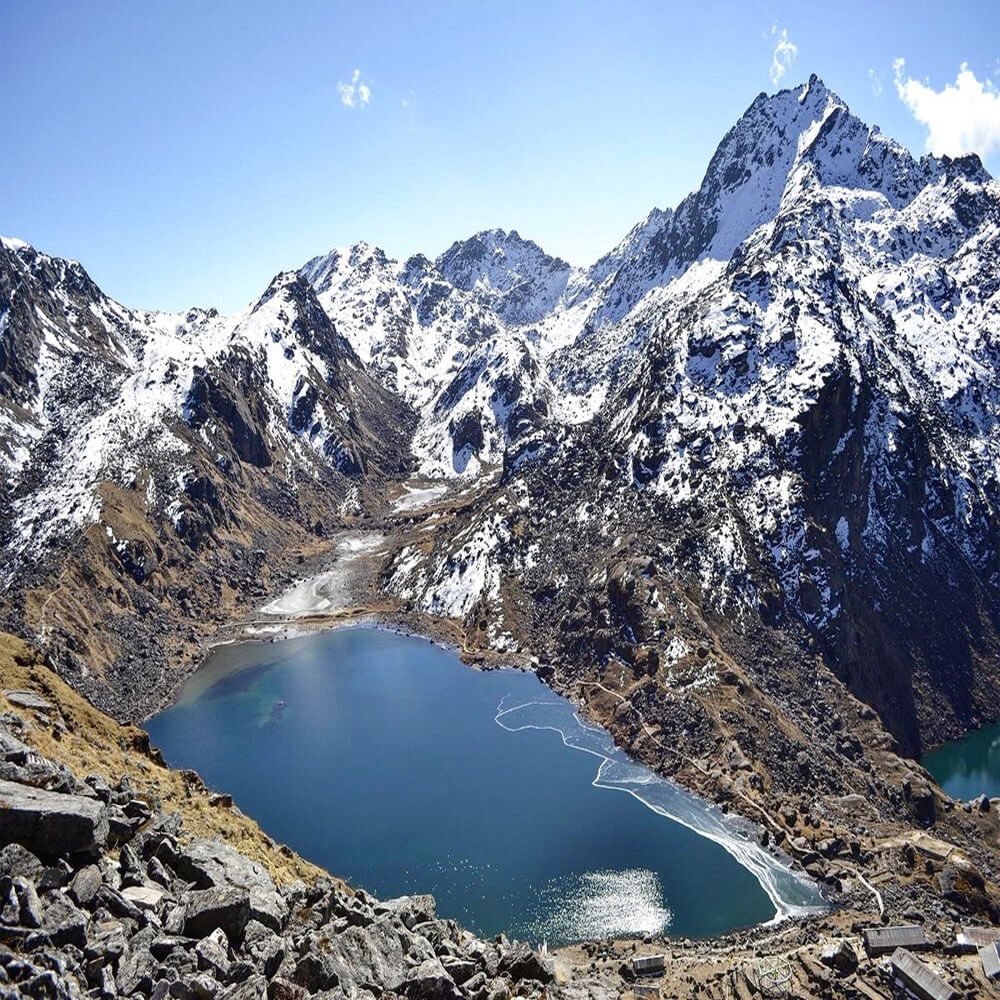
As a moderate trip, the Langtang Valley trip is appropriate for beginner and intermediate trekkers who are fit and ready for high-altitude trekking. Langtang offers a shorter route with acceptable daily walking distances, usually 5–7 hours per day, in contrast to lengthier and more taxing treks like the Annapurna Circuit or Everest Base Camp.
Beginning at Syabrubesi (1,503m), the hike progressively climbs to Langtang Village (3,430m) over forests, riverbanks, and terraced fields. Although the optional side treks to Kyanjin Ri (4,773m) or Tsergo Ri (4,984m) introduce higher climbs and more difficult terrain, the moderate elevation rise enables trekkers to acclimate efficiently.
There are narrow routes that call for balance and caution, rocky paths, suspension bridges, and occasionally landslide-prone areas. The weather can also affect difficulty; snow, rain, or cooler temperatures make things more difficult.
Despite the mild difficulty of the trek, acclimatization, appropriate equipment, and physical fitness are crucial. Trekkers should be ready for long trekking days, shifting altitudes, and difficult terrain.
All things considered, the Langtang Trek is a rewarding Nepal trekking experience that blends natural beauty, cultural encounters, and expansive Himalayan views. It is also reasonably easy to complete, making it suitable for novice hikers who wish to experience high-altitude trekking in a picturesque and culturally diverse area.
Shortest and Longest Trail Variations of Langtang Valley Trek
Trekkers can better anticipate effort, length, and logistics by being aware of the various trail differences when planning the Langtang Valley Trek. You can modify the hike based on your desired distance, side visits, and acclimatization days.
Standard Route Distance
The most popular Langtang National Park trekking route starts at Syabrubesi, about 120 kilometers from Kathmandu, and returns there. Depending on detours, this typical route travels between 60 and 70 km round trip. Trekkers usually need 7–10 days to complete this traditional route, arriving at Kyanjin Gompa (3,870m), the Langtang region's main community and cultural center. For those looking for a moderate yet engaging trekking experience in the Himalayas, the Langtang trek total kilometers on this route is perfect.
Side Trips and Extended Routes
Optional side visits might prolong the walk for those seeking greater excitement. Kyanjin Ri (4,773m) and Tsergo Ri (4,984m) are well-liked expansions. These excursions, which add 8–10 km to the Langtang trek total kilometers, provide expansive vistas of the Himalayas and glacial landscapes. These deviations enhance the walking experience while also aiding in acclimatization and prepare hikers for higher elevations.
Shorter Variations for Beginners or Limited Time
Trekkers can begin at the Lama Hotel rather than Syabrubesi if time or fitness are an issue, which will shorten the daily walking distance. The journey can conclude in Kyanjin Gompa or Langtang Village and then resume on the same path. This condensed version preserves the beauty of the Langtang National Park trekking route while cutting the Langtang trek total kilometers to a manageable 5–6 day duration.
Longer Variations for Experienced Trekkers
In order to make the trek more difficult and involve longer daily distances, experienced hikers may choose to extend their journey to include side valleys, glaciers, or the high-altitude Tserko Ri summit. This option offers a more thorough investigation of the Langtang National Park trekking route, incorporating isolated landscapes and unspoiled Himalayan environment, and raises the overall number of kilometers for the Langtang trek—it can occasionally surpass 75 km round trip.
Trekkers can strike a balance between distance, difficulty, and sightseeing by selecting the appropriate route variant. Knowing the Langtang trek start and end points and potential side trips guarantees a fulfilling and unique Himalayan experience.
Walking Hours vs Trekking Distance on the Langtang Valley Trek
Planning the Langtang Valley trek requires an understanding of the difference between walking hours and trekking distance. The trek's high-altitude terrain and moderate daily distances may have an impact on pace. Trekkers who plan ahead are better able to assess their energy needs, acclimatization, and general comfort levels.
Langtang Trek Duration in Days
For the standard route from Syabrubesi to Kyanjin Gompa and back, the Langtang trek usually takes 7 to 10 days. Trekkers can prolong the journey to 11–12 days if they choose to undertake side hikes like Kyanjin Ri (4,773m) or Tsergo Ri (4,984m). The daily distance ranges from 8 to 12 kilometers, but even short excursions might take a long time because of the steep trails and high elevation.
Langtang Trek Walking Hours per Day
Walking the Langtang journey takes five to seven hours on average each day. Trekking from Syabrubesi to Lama Hotel or from Lama Hotel to Langtang Village are examples of lower-altitude days that typically take five to six hours. Because of the thinner air and steeper slopes, higher-altitude days, such as climbing to Kyanjin Gompa or trying side climbs, may take six to seven hours or longer. To avoid weariness and enable appropriate acclimatization, rest periods are crucial.
Factors Affecting Daily Walking Hours
- Altitude: As elevation increases, trekkers move more slowly.
- Trail Conditions: Rocky paths, river crossings, and landslide-prone sections can extend walking time.
- Weather: Rain, snow, or wind can slow the pace significantly.
- Fitness Level: Well-prepared trekkers cover distances faster; beginners may need extra time.
Tips for Managing Trekking Hours
- Start early to maximize daylight hours.
- Maintain a steady, moderate pace to conserve energy.
- Stay hydrated and take short breaks every hour.
- Adjust itinerary if walking hours feel too strenuous, prioritizing safety and enjoyment.
Trekkers can plan a realistic, pleasurable journey that balances challenge with scenic and cultural experiences along this stunning Himalayan path by knowing the relationship between the Langtang trek walking hours per day and the trek duration in days.
Langtang Trek Altitude Gain – Understanding the Trek’s Elevation Profile
The Langtang Valley Trek is well known for its breathtaking scenery, diverse culture, and moderate level of difficulty. Understanding the Langtang trek elevation gain and its altitude profile is crucial for planning this journey because it has a big impact on acclimatization requirements, pace, and daily walking hours.
Starting Elevation and Initial Gain
Syabrubesi (1,503 meters), a small town reachable by car from Kathmandu, is where the walk starts. Trekkers continue through verdant forests and traditional communities as they progressively ascend from this point. The first ascent is gradual, allowing the body to adjust to greater elevations while traveling 8–10 km daily. It is essential to understand this aspect of the Langtang trek altitude profile in order to pace and avoid early weariness.
Gains in Mid-Trek Elevation
The elevation gradually increases as hikers pass past Lama Hotel, Langtang Village, and Lama Hotel. The total height rise from the beginning point surpasses 1,900 meters by the time you arrive at Langtang Village (3,430 meters). Steeper trails and sporadic rocky terrain are features of this region. Dealing with the thinner air at these levels requires proper drinking and frequent rest periods.
Highlights and Possible Treks
Side treks are when the trip reaches its highest heights. Ascending to Kyanjin Ri (4,773 meters) or Tsergo Ri (4,984 meters) begins at Kyanjin Gompa (3,870 meters). These optional ascents are the most important daily Langtang trek elevation gain and call for appropriate acclimatization and cautious pace. At some locations, the altitude profile exhibits steep vertical increases over brief distances, which can be taxing on the body.
Descent and Cumulative Elevation Loss
Trekkers descend back to Syabrubesi on the way back. Walking downhill puts strain on the knees and ankles even if it is less harmful to the lungs. In addition to lowering the hazards associated with altitude, the cumulative elevation loss reflects the ascent and offers a sense of success.
Why Understanding the Altitude Profile Matters
Reviewing the Langtang trek altitude profile helps hikers efficiently schedule rest days, optional treks, and daily distances. Understanding elevation gains makes the climb safer and more pleasurable, helps avoid altitude sickness, and guarantees appropriate energy management.
In conclusion, anyone organizing this Himalayan trip must monitor the elevation gain on the Langtang trek and understand the altitude profile. It enables trekkers to overcome everyday challenges while taking full advantage of the breathtaking landscapes and cultural encounters along the route.
Fitness and Preparation for Langtang Valley Trek
Trekking in the Langtang region offers stunning views of the Himalayas, but it takes preparation to handle the daily distances and high-altitude slopes. For the moderate but difficult walk, a well-organized Langtang region trekking guide places a strong emphasis on mental preparedness, endurance, and physical condition.
Cardiovascular Training for Endurance for Langtang Trekking
To handle the five to seven hours of daily trekking, endurance is crucial. Trekkers should do aerobic activities like swimming, cycling, brisk walking, or running. By strengthening the heart and lungs, these exercises assist the body in adjusting to the thinner air at higher elevations. Interval training can help increase endurance for strenuous climbs on the Langtang routes.
Strength Training for Hiking Muscles
For navigating uneven trails, high inclines, and descents, strong leg and core muscles are essential. While planks and bridges build the core, exercises like squats, lunges, step-ups, and calf raises target the leg muscles. In order to simulate trail conditions and increase endurance, trekkers might also practice trekking on hills or staircases while carrying a weighted backpack.
Flexibility and Balance Exercises
Injuries on uneven ground are less likely when one is flexible. During long trekking days, stretching exercises that focus on the shoulders, back, and legs assist keep muscles healthy. Yoga and stability training are examples of balance activities that enhance coordination and facilitate navigating slippery or tight paths.
Acclimatization Preparation
Although the Langtang trek does not go as high as Everest or Manaslu, it still require acclimatization over time at high spots like Kyanjin Ri (4,773m). Prior to the trek, hikers should plan rest days along the way and practice longer hikes at moderate elevations. Maintaining sufficient hydration and nutrition throughout training aids in the body's preparation for trekking at high elevations.
Mental Preparation and Trekking Strategy
Mental toughness is also essential for a successful hike. It is crucial to be ready for long hiking days, unforeseen weather changes, and remote terrain conditions. To make the trip safer and more pleasurable, a Langtang region trekking guide advises trekkers to pace themselves, take frequent pauses, and keep a good outlook.
Trekkers may comfortably cover daily distances, take in the breathtaking scenery, and securely appreciate the natural and cultural diversity of the Langtang region by according to this fitness and preparation plan, which will make the expedition memorable and fulfilling.
Best Time for Langtang Valley Trek
Although the Langtang Valley Trek is possible all year round, spring (March to May) and autumn (September to November) are the ideal seasons to go. Trekking is most pleasurable during these seasons because of the beautiful skies, pleasant temperatures, and breathtaking mountain views.
With the valley bursting into color with blossoming rhododendrons, wildflowers, and lush foliage, spring is particularly lovely. Although evenings might still be cold at higher elevations, trekking is comfortable due to the daytime temperatures. Because the wildlife and flowers are at their best in the spring, it is also the perfect time of year for photographers and nature lovers.
The best visibility and consistent weather make autumn the most popular time of year for trekking. With clear skies following the monsoon, one can enjoy expansive vistas of Ganesh Himal, Langtang Lirung, and other Himalayan peaks. The nights are still cold but tolerable with the right equipment, and the days are lovely.
Particularly above Kyanjin Gompa (3,870m), winter (December–February) brings snow and colder temperatures, which make some trails slick and more difficult. Leeches, landslides, and severe rainfall make the monsoon season (June–August) largely avoidable.
Your Langtang Valley trekking expedition will be unforgettable and fulfilling if you schedule your trek for spring or autumn, when the weather, natural beauty, and safety are all at their best.
Distance Comparison with Other Treks
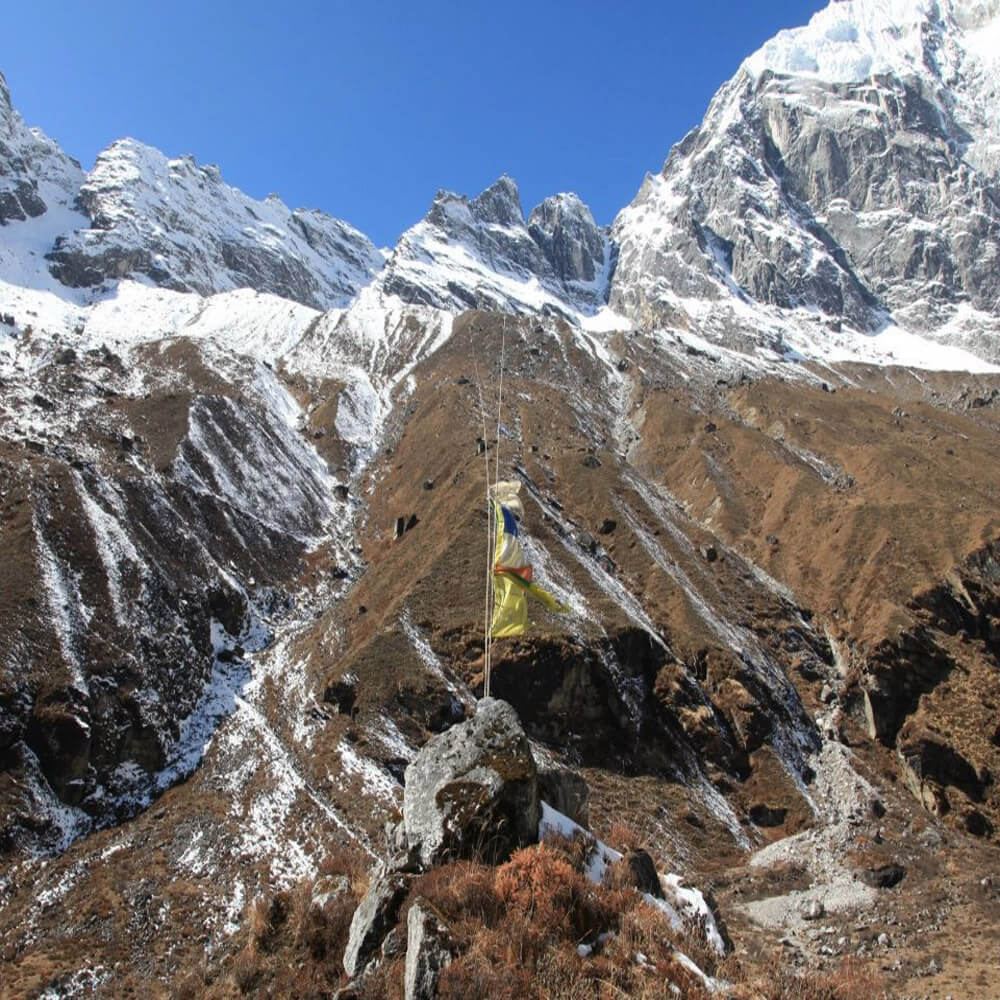
Trekkers can make better plans, determine the level of difficulty, and select a trip that suits their schedule and fitness level by knowing how far the Langtang Valley trek is from other well-known Nepali treks.
Langtang Valley Trek vs Everest Base Camp Trek
In comparison, the Everest Base Camp Trek is about twice as long as the Langtang Valley Trek, which is about 60 to 70 kilometers round trip. Langtang's shorter distance makes it more approachable for trekkers with limited time or those looking for a mild Himalayan experience in Nepal, even if Everest gives famous Himalayan views of the world's tallest peak. Although altitude is still a challenge on both treks, the average daily walking time on Langtang is 5–7 hours, while on Everest it is 6–8 hours.
Langtang Valley Trek vs Annapurna Base Camp Trek
The Annapurna Base Camp Trek has moderate to difficult elevation rises and is roughly 110 km round trip, including side trips. The Langtang journey, in contrast, is shorter and less crowded, which makes it perfect for hikers who wish to experience the Himalayan wildness, Tibetan culture, and beautiful landscapes in balance without committing to a lengthy expedition. In order to provide flexibility in terms of distance and effort, Langtang also offers optional side climbs such as Kyanjin Ri (4,773m) and Tsergo Ri (4,984m).
Langtang Valley vs Other Popular Treks in Nepal
The Manaslu Circuit Trek (~177 km) is much longer and more difficult than other well-known treks like Ghorepani Poon Hill (~35 km) or Helambu Trek (~45–50 km). Langtang is a good option for explorers looking for rewarding but mild Himalayan adventures since it falls somewhere in the middle: it is longer than beginning treks but shorter than high-altitude, multi-week circuits.
The Langtang Valley Trek offers trekkers a fulfilling blend of adventure, culture, and stunning vistas while avoiding the excessive distances of some lengthier Nepal treks. It does this by striking the perfect balance between doable distance and Himalayan grandeur.
Challenges Related to Distance and Terrain on Langtang Valley Trek
Although trekking through the Langtang Valley is a once-in-a-lifetime experience, there are some difficulties that any hiker should be aware of. Even a very short walk can feel taxing due to the mix of distance, altitude, and rough terrain. Here is a thorough analysis of the primary difficulties.
Steep Sections and Rocky Trails
There are many severe climbs and descents in the Langtang Valley Trek. Trekkers begin their ascent from Syabrubesi and ascend progressively through terraced slopes and thick forests. Particularly rocky areas around Kyanjin Gompa and Langtang Village call for hiking poles and careful footing. These rough trails can slow down the pace of the trekking schedule and be physically difficult, particularly while carrying a heavy rucksack.
Landslide-Prone Areas
Following the 2015 earthquake, landslides and path collapses were more common in some areas of the Langtang region. Trails may become even more unstable during the monsoon season due to heavy rainfall. Because these areas might become hazardous, trekkers should closely follow local guidance and weather warnings. One way to lower dangers is to avoid damp pathways and go for an early morning walk.
River Crossings and Narrow Bridges
A number of rivers and streams traverse the Langtang path. Some smaller creeks require natural crossings or stepping over rocks, but the majority have suspension bridges. Water levels rise during snowmelt or during the wet season, making many crossings more difficult. Safety requires careful balance and appropriate footwear with good grip.
Effects of High Altitude on Trekking Distance
The high-altitude terrain makes the Langtang Valley Trek seem longer, even though the whole trip is only about 60 to 70 km. Oxygen levels drop over 3,000 meters, which results in exhaustion and reduced walking rates. Acclimatization at locations like Kyanjin Gompa is crucial because even little daily distances can feel taxing.
Trail Navigation and Forest Paths
The trek's lower portions go through thick pine and rhododendron forests, where it may be harder to see the pathways. Trekkers may come across small passageways, fallen trees, and muddy or slick pathways. Using a map or guide guarantees safe navigation and keeps you on course.
By understanding these challenges, trekkers can better prepare physically and mentally for the Langtang Valley Trek, ensuring a safer and more enjoyable experience while appreciating the breathtaking Himalayan scenery.
FAQs
What long is Langtang Valley Trek?
The trek covers approximately 60–70 kilometers round trip, depending on optional side trips such as Kyanjin Ri or Tsergo Ri.
How many days does it take to complete the trek?
Typically, the trek takes 6–8 days. This allows for manageable daily distances and proper acclimatization while enjoying the scenic valley.
How far do trekkers walk each day?
Daily walking distances vary from 8–12 km, which usually takes 5–7 hours depending on terrain, altitude, and stops along the way.
Does the distance feel more challenging at higher altitudes?
Yes, even short distances can feel strenuous above 3,500 meters due to lower oxygen levels and steep ascents. Acclimatization and pacing are essential to handle fatigue.
How does Langtang compare to other Nepal treks in distance?
Langtang is shorter than Everest Base Camp (130 km) and Annapurna Circuit (160 km), making it ideal for trekkers looking for a moderate Nepal trekking adventure with manageable distances, stunning Himalayan views, and cultural experiences without committing to a long-duration trek.
Conclusion: Langtang Valley Trekking Distance
The Langtang Valley Trek, which covers a total trekking distance of roughly 60 to 70 kilometers round trip, provides a moderate but rewarding Himalayan adventure. Despite being shorter than other well-known treks like the Annapurna Circuit or Everest Base Camp, the combination of rocky paths, steep ascents, and high-altitude locations like Kyanjin Ri (4,773m) makes it a worthwhile challenge.
Trekkers encounter an ideal fusion of Tibetan-influenced culture, breathtaking views of snow-capped peaks, and the natural beauty of the area. Both novice and expert hikers may complete the trek with the right planning, pace, and acclimatization. Trekkers may concentrate on taking in the Langtang Valley's scenery, communities, and tranquil wildness without feeling overpowered thanks to its moderate distance.

